
Astragalus alpinus is a species of flowering plant in the legume family known by the common name alpine milkvetch. It has a circumpolar distribution, occurring throughout the upper latitudes of the Northern Hemisphere.

Lupinus arizonicus, the Arizona lupine, is a flowering plant in the legume family Fabaceae, native to the Mojave and Sonoran Deserts of North America, where it can be found growing in open places and sandy washes below 1,100 metres (3,600 ft) elevation. It is common around Joshua Tree National Park and Death Valley National Park in California.

Monoptilon bellioides, the desert star, also called Mojave desertstar, is a desert flowering plant in the family Asteraceae.
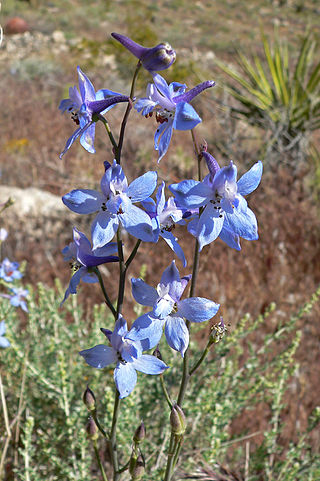
Delphinium parishii, the desert larkspur, is a flowering plant in the family Ranunculaceae native to the Mojave Desert, in the southwestern United States and northwest Mexico. In Southern California it is also found in the Tehachapi Mountains, Transverse Ranges, and eastern Sierra Nevada.

Phacelia fremontii is a flowering plant in the family Boraginaceae native to the southwestern United States. In California, its range includes the Mojave Desert, the San Joaquin Valley, the Coast Ranges, and the Sierra Nevada. It was named for John C. Frémont.
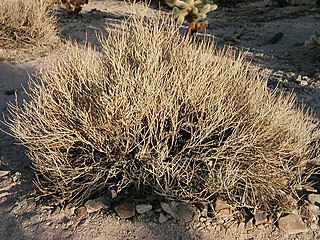
Senna covesii is a perennial subshrub in the family Fabaceae, native to the Mojave Desert and Sonoran Desert in southeastern California, southern Nevada, and Arizona in the United States, and northern Baja California in Mexico. It is found on desert plains and in sandy washes between 500 and 600 m above sea level, and is very common in Joshua Tree National Park. The specific epithet honors ornithologist Elliott Coues.

The Kiavah Wilderness is a federally designated wilderness area located in the Mojave Desert, Scodie Mountains, and southern Sierra Nevada in Kern County, California, United States. California State Route 178 connects the town of Lake Isabella to State Highway 14 in the east, crossing Walker Pass at the north boundary of the wilderness.
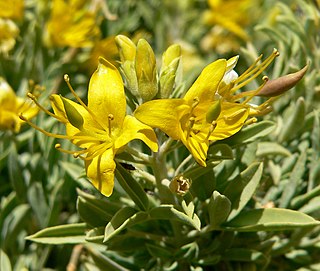
Cleomella arborea, is a perennial shrub or bush in the spiderflower family (Cleomaceae) known by the common names bladderpod, bladderpod spiderflower and burro-fat. It has yellow flowers in bloom all months of the year. It emits a foul odor to discourage herbivory from insects.

Astragalus trichopodus is a species of legume known by the common name Santa Barbara milk vetch. It is native to southern California and Baja California, where it grows in several types of open habitat, including in the Transverse Ranges and Mojave Desert.

Astragalus bernardinus, known by the common name San Bernardino milkvetch or the Lesser Three-keeled Milkvetch, is a species of milkvetch. It is a plant of desert and dry mountain slope habitat. It is native to California.

Astragalus casei is a species of milkvetch known by the common name Case's milkvetch. It is native to the Mojave Desert and its sky island woodlands of eastern California and western Nevada.

Astragalus cimae is a species of milkvetch known by the common name Cima milkvetch. It is native to the Mojave Desert and its sky island woodlands of eastern California western Nevada, especially on calcareous soils, including the Cima Dome area in the Mojave National Preserve.
Astragalus mohavensis is a species of milkvetch known by the common name Mojave milkvetch. It is native to the Mojave Desert of California and Nevada.
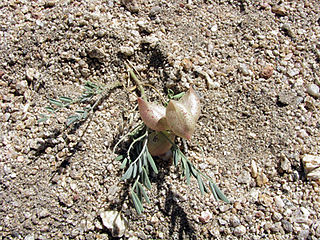
Astragalus nutans is a species of milkvetch known by the common name Providence Mountains milkvetch.
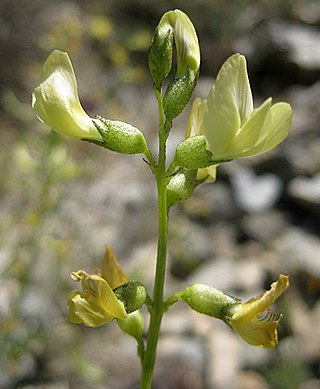
Astragalus tricarinatus is a rare species of milkvetch known by the common name triplerib milkvetch, or triple-ribbed milkvetch.

Rafinesquia neomexicana is a species of flowering plant in the family Asteraceae. Common names include desert chicory, plumeseed, or New Mexico plumeseed. It has white showy flowers, milky sap, and weak, zigzag stems, that may grow up through other shrubs for support. It is an annual plant found in dry climate areas of the southwestern deserts of the US and northwestern deserts of Mexico.
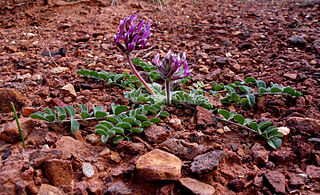
Astragalus holmgreniorum is a rare species of milkvetch known by the common names Holmgren milk-vetch and paradox milk-vetch. It is native to a tiny section of desert shrub woodland on the border between Utah and Arizona, in the far northern Mojave Desert. There are six populations remaining. It is a federally listed endangered species.
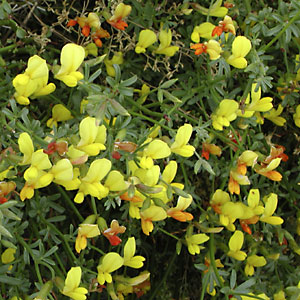
Acmispon rigidus, synonyms Lotus rigidus and Ottleya rigida, is a flowering plant in the pea family (Fabaceae), native to the southwestern United States and northwestern Mexico. It is known as shrubby deervetch or desert rock-pea. It is found in the Mojave Desert and Sonoran Desert.
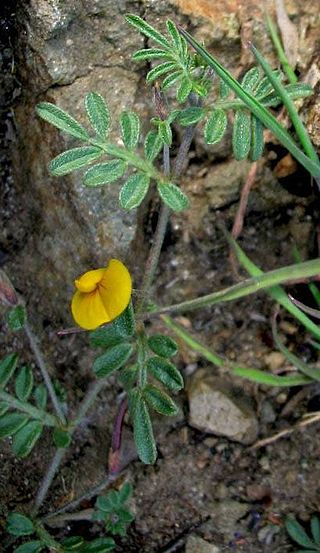
Acmispon strigosus, synonyms Lotus strigosus and Ottleya strigosa, is a flowering plant in the pea family (Fabaceae), native to the southwestern United States and northern Mexico. It is known as stiff-haired lotus or strigose bird's-foot trefoil.
Astragalus flavus is a perennial plant in the legume family (Fabaceae) found in the Colorado Plateau and Canyonlands region of the southwestern United States.



















